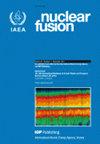Bayesian modelling of multiple plasma diagnostics at Wendelstein 7-X
IF 4
1区 物理与天体物理
Q1 PHYSICS, FLUIDS & PLASMAS
引用次数: 0
Abstract
Inference of electron density and temperature has been performed using multiple, diverse sets of plasma diagnostic data at Wendelstein 7-X. Predictive models for the interferometer, Thomson scattering and helium beam emission spectroscopy (He-BES) systems have been developed within the Minerva framework and integrated into a unified model. Electron density and temperature profiles are modelled using Gaussian processes. Calibration factors for the Thomson scattering system and predictive uncertainties are considered as additional unknown parameters. The joint posterior probability distribution for the electron density and temperature profiles as well as Gaussian process hyperparameters and model parameters is explored through a Markov chain Monte Carlo algorithm. Samples from this distribution are numerically marginalised over the hyperparameters and model parameters to yield marginal posterior distributions for the electron density and temperature profiles. The profile inferences incorporate various data combinations from the interferometer and Thomson scattering as well as constraints at the limiter/divertor positions through温德斯坦 7-X 号多重等离子体诊断的贝叶斯模型
利用温德斯坦 7-X 的多组不同等离子体诊断数据,对电子密度和温度进行了推断。在 Minerva 框架内开发了干涉仪、汤姆逊散射和氦束发射光谱(He-BES)系统的预测模型,并将其整合为一个统一的模型。电子密度和温度曲线采用高斯过程建模。汤姆逊散射系统的校准因子和预测不确定性被视为额外的未知参数。通过马尔科夫链蒙特卡洛算法探索了电子密度和温度曲线以及高斯过程超参数和模型参数的联合后验概率分布。通过对超参数和模型参数进行数值边际化,从该分布中提取样本,从而得到电子密度和温度剖面的边际后验分布。剖面推断结合了来自干涉仪和汤姆逊散射的各种数据组合,以及通过虚拟观测或来自 He-BES 的边缘数据对限幅器/分流器位置的约束。此外,还介绍了将 X 射线成像晶体光谱仪数据纳入离子温度剖面模型的情况。本研究中介绍的所有剖面都是通过探索联合后验分布,应用贝叶斯奥卡姆剃刀,以优化选择的超参数和模型参数推断出来的。
本文章由计算机程序翻译,如有差异,请以英文原文为准。
求助全文
约1分钟内获得全文
求助全文
来源期刊

Nuclear Fusion
物理-物理:核物理
CiteScore
6.30
自引率
39.40%
发文量
411
审稿时长
2.6 months
期刊介绍:
Nuclear Fusion publishes articles making significant advances to the field of controlled thermonuclear fusion. The journal scope includes:
-the production, heating and confinement of high temperature plasmas;
-the physical properties of such plasmas;
-the experimental or theoretical methods of exploring or explaining them;
-fusion reactor physics;
-reactor concepts; and
-fusion technologies.
The journal has a dedicated Associate Editor for inertial confinement fusion.
 求助内容:
求助内容: 应助结果提醒方式:
应助结果提醒方式:


